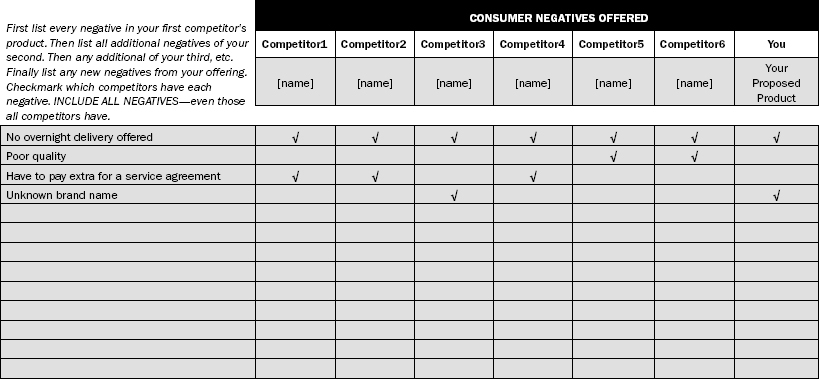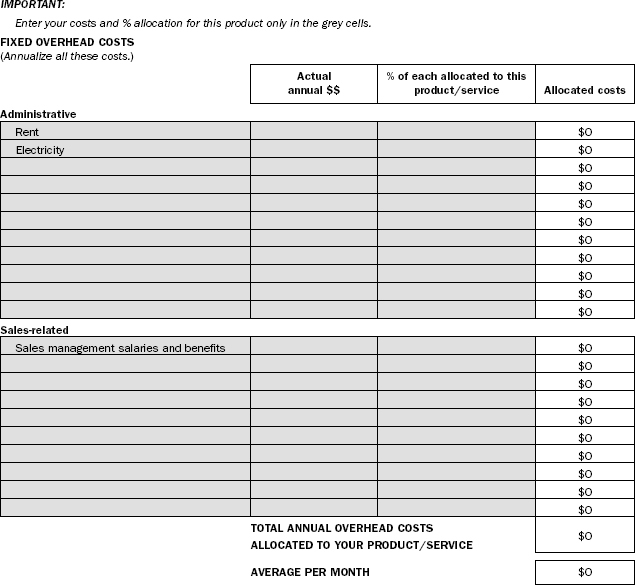Appendix of Worksheets
These worksheets are here for your convenience, but they are much more valuable if you go to this book’s companion web site (www.wiley.com/go/jensenprices). and use them as Excel spreadsheets. Many of the calculations are completed for you automatically in the Excel models.
The Competitor Pricing Worksheet
Chapter 3: Analyzing Your Competitors’ Prices ©2013 PricingStrategyAssoc.com
SERVICE BUSINESS WORKSHEET
How to use this sheet: Pick the primary (in terms of quantity and profitability) services you offer and list in the first column. In the second “Add-Ons” column, list add-on services people can buy when they buy each primary service. Then list the names of your major competitors across the top row. Finally, find out (however you can) your competitors’ prices for each and list them in the appropriate boxes. FILL IN THE GREY BOXES!
IN-A-RUSH TIPS: Don’t skip this—it’s one of the most critical steps. It will tell you what your targets EXPECT to pay, which is essential knowledge. However . . . you can save time by picking only your three or four main competitors and main services. But it will cost you some quality. For example, by looking at additional competitors you may find additional services they are offering that you might be able to profit from yourself!
(See the following pages for different types of business worksheets.)


Chapter 3: Analyzing Your Competitors’ Prices ©2013 PricingStrategyAssoc.com
PRODUCT BUSINESS WORKSHEET
How to use this sheet: Pick the primary (in terms of quantity and profitability) products you offer and list them down Column B. Also list (Column C) any addon products people can buy when they buy each primary product. Then list the names of your major competitors across Row 8. Finally, find out (however you can) your competitors’ prices for each and list them in the appropriate boxes. FILL IN THE GREY BOXES!
IN-A-RUSH TIPS: Don’t skip this—it’s one of the most critical steps. It will tell you what your targets EXPECT to pay, which is essential knowledge. However . . . you can save time by picking only your three or four main competitors and main products. But it will cost you some quality. For example, by looking at additional competitors you may find additional products they are offering that you might be able to profit from yourself!
(See the following pages for different types of business worksheets.)


Chapter 3: Analyzing Your Competitors’ Prices ©2013 PricingStrategyAssoc.com
SPONSOR OPPORTUNITIES BUSINESS WORKSHEET
How to use this sheet: Pick the primary (in terms of quantity and profitability) sponsor opportunities you offer and list them down Column B. Also list (Column C) any add-on sponsor opportunities people can buy when they buy each primary sponsor opportunity. Then list the names of your major competitors across Row 8. Finally, find out (however you can) your competitors’ prices for each and list them in the appropriate boxes. FILL IN THE GREY BOXES!
IN-A-RUSH TIPS: Don’t skip this—it’s one of the most critical steps. It will tell you what your targets EXPECT to pay, which is essential knowledge. However . . . you can save time by picking only your three or four main competitors and main sponsor opportunities. But it will cost you some quality. For example, by looking at additional competitors you may find additional sponsor opportunities they are offering that you might be able to profit from yourself!
(See the following pages for different types of business worksheets.)


The Buyer Benefits Worksheet
Chapter 6: Analyzing Buyer Benefits/Negatives Relative to Your Competitors ©2013 PricingStrategyAssoc.com
How to use this sheet: Don’t list product attributes (e.g., 600 MB), but instead list the BENEFITS consumers get from them (e.g., faster speeds). FILL IN THE GREY BOXES!
IN-A-RUSH TIPS: Don’t skip this—it’s one of the most critical steps. It will tell you what your targets GET and what ANNOYS THEM in your marketplace. You can save time by picking only your three or four main competitors, but it will cost you some quality. For example, by looking at additional competitors you may find additional positives to add to your new product and/or negatives to remove.


The Narrowing Your Price Range Worksheet
Chapter 7: Narrowing Your Price Range Worksheet ©2013 PricingStrategyAssoc.com
How to use this six-step worksheet: Review the material in Chapter 7, and in the Chapter 3 Worksheet. Be prepared to copy material from the Chapter 6 worksheet into this worksheet (to save time). FILL IN THE GREY BOXES!
IN-A-RUSH TIP: Don’t skip this—it’s one of the most critical steps.



The Cost Analysis Worksheet
Chapter 8: Evaluating Your Costs ©2013 PricingStrategyAssoc.com
TOTAL OF ALL COSTS ON THE FOLLOWING THREE WORKSHEETS

Chapter 8: Evaluating Your Costs ©2013 PricingStrategyAssoc.com
Direct Costs Worksheet

Chapter 8: Evaluating Your Costs ©2013 PricingStrategyAssoc.com
Overhead Costs Worksheet

Chapter 8: Evaluating Your Costs ©2013 PricingStrategyAssoc.com
Sunk Costs Worksheet

